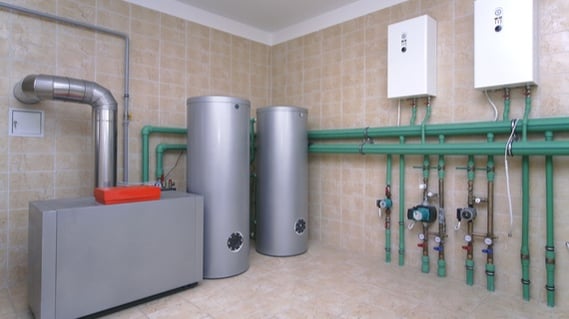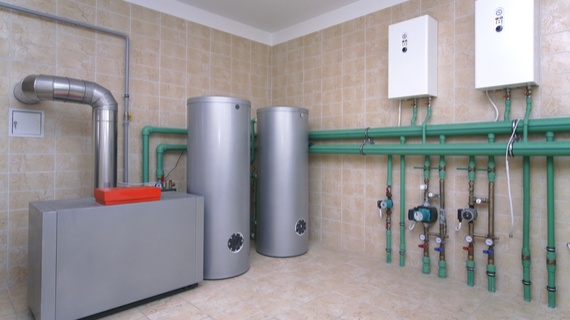
Water systems provide a bountiful potential breeding ground for the naturally-occurring legionella bacterium for the simple reason that certain temperatures present – and subject to unobserved fluctuation - in said systems can then foster the growth of the health-impacting bacteria. Essentially, once the bacteria compromises water systems in the built environment, prevalent conditions (if not controlled and monitored) can lead to significant and rapid growth; which when interacted with by humans can encourage the manifestation of pneumonia. Therefore legionella is classed as a biological hazard and as such demands appropriate legionella temperature control checks to be routinely undertaken, and which habitually encompass conventional water systems commonly found in the workplace.
With regards to both hot and cold water systems which could pose legionella risks, there are ordinarily the three predominant types of systems which fall under the following headings; ‘smaller hot and cold water systems’ (for example those directly fed mains cold water to outlets with localised points of use – i.e. water heaters), ‘gravity-fed cold water systems’ (think storage tanks – cisterns – and more sizeable water heating vessels – calorifiers – for the provision of hot water), ‘pressurised systems’ (either directly mains-fed or incorporate storage and booster pumps supplying cold water and unvented water heaters with or without secondary recirculation) and ‘hot water heaters’ (calorifiers and hot water cylinders – primary heating circuits of low pressure hot water or steam which is passed through a heat exchanger inside the vessel and source power from gas/oil flame, electricity or external heat exchanger). As is the general understanding, temperature control remains steadfastly the key to ensuring that the threat of legionella is kept at bay at all times in buildings (both domestic and commercial). As a recap – or conversely, as a timely flagging up for the interests of the uninitiated – the following vital pointers (in terms of water temperature control) should be strictly governed and adhered to:
- 60°C (or above) – The temperature hot water should be systematically stored at within the contextual surround of cylinders/calorifiers
- 50°C (or above) – The temperature at which hot water should be distributed (thermostatic mixer valves need to be fitted as close as possible to outlets, where a scald risk is identified)
- 19°C (or below) – The temperature at which cold water should be stored and distributed
As we’ve already stressed, there isn’t just the singular type of water system which fundamentally supplies either hot or cold water, as there are a few predominant genres in widespread facilitation, and all of which differ in size, scale and complexity. Yet despite this we always return to the subject which focuses on the most pivotal and far-reaching means of minimising the risk of legionella materialising; that being temperature control awareness and actions. Along with regular maintenance of the assemblage in place, of course. And suffice to say, prior to assessing the risks typically posed by these systems, the person(s) responsible needs to be fully aware of the rudiments of said systems in their governance, including the constituent parts and operation.
Smaller hot and cold water system
Firstly, smaller hot and cold water systems – traditionally located in domestic premises and taking the guise of combination boilers for instance – tend to accommodate low volumes of stored water (averaging in the region of 15-litres or less), where the general purpose of said apparatus is to heat the liquid contents to a set temperature. Such appliances normally deliver a small amount of stored hot water before a recovery period, which subsequently return the temperatures back to the set point. These systems generally tend to be low-risk for legionella risk, however temperature monitoring is still highly recommended. Meanwhile combination storage water heaters are in the habit of storing a quantity of cold water (above 15-litres) directly above the hot water reservoir, which effectively sees the cold water header tank feed the hot water storage vessel as the latter is recruited on demand by the end user. In this scenario a cold water header tank is refilled directly via a cold water supply, and usually employing a float-operated valve mechanism. The combination water heater is historically equipped with an expansion pipe so that any expanding hot water returns into the cold water header tank. By virtue of its unique design, a combination storage water heater may allow hot water to enter the cold water space, and with this in mind a cold water maximum benchmark temperature of 25°C is set when and where it serving other outlets; or 38°C when serving the hot water vessel only.
What level of legionella risk assessment measures should be adopted in this situations?
Our advice would be to give careful consideration to risk management from the outset when it comes to these types of systems, where thermostat priority should be afforded. In as much as set as close to 60°C as is practicable (although not exceeding it), while hot water derived from the outlets should be at a recognised minimum of 50°C (55°C in healthcare premises). Obviously there will be times when it’s not possible to manually verify these temps – periods of low usage, characterized by overnight and/or weekend – so it’s imperative to counter the legionella risk at these forewarned junctures by fitting a timer which automatically overrides immersion heater settings via pre-set switchgear.
Possible Flashpoints – Because the abovementioned header tanks in some combination storage units are divided into two sections (one feeding the water heater beneath, the other supplying water to the closed heating system), there’s always the threat of cross-contamination; ergo poor temperatures should be considered as part of any risk assessment.
Name another type of water system, then, and explain the basics?
‘Gravity-fed water systems’ with (and without) recirculation principles are pretty ubiquitous in the UK too. With regards to the former, they are more often than not installed in domestic properties and more compact buildings. In terms of application, cold water enters the building from what’s known as a rising main and is thereafter collected in a cold water tank. This reservoir provides backflow protection to the mains supply and a stable pressure and reserve in the system. Should the system experience a mains pressure fail (or demand exceeds the capacity of the mains supply) cold water from the tank is then fed to the calorifier (hot water cylinder) where it is heated and ultimately drawn via pipes that branch to sinks, washbasins, baths, showers etc. Contrasting dedicated recirculating systems (as described above); the water only flows during usage and normally cools within the pipes post-facilitation.
On the other hand, gravity-fed system WITH recirculation protocols are typically discovered in larger, more commercial properties. Although ostensibly mirroring the alternative means cited above (i.e. cold water enters the building from a rising main, stored in a cold water storage tank, tank provides backflow protection to the mains supply and a stable pressure in the system, cold water feed the calorifier, etc), the noted difference comes in the form of a continuous circulation of hot water from the calorifier around the distribution circuit (and back to the calorifier) by means of one or more pumps. For the most part said pumps are installed on the return to the calorifier, but it can be located on the flow. This ensures hot water is instantly available at any of the taps, independent of their distance from the calorifier, and thus minimises the risk of localised temperature fluctuations. To clarify, the circulation pump is sized to compensate for the heat losses from the distribution circuit so that the return temperature to the calorifier never dips below the 50°C mark.
Possible Flashpoints – For the record, the pump has limited effect on tap pressure, which is based on relative height at which the storage tank is positioned. Discharge into the cold water storage tank is not advised as this can result in warm storage water temperatures, which in turn proves clement for microbial growth.
Any other mainstream water systems worth mentioning?
‘Pressurised systems’ is the other widespread variation on a theme, which are ordinarily fed directly by a pressurised supply connected to the calorifier, water heater or heat exchanger. In these set-ups, water expands when heated, necessitating an expansion vessel, safety temperature and pressure relief valve. Hot water distribution can be a recirculating or non-recirculating system in this context. And last but not least, ‘hot water heaters’ (calorifiers and hot water cylinders) are water storage vessels heated by either heating circuits of low pressure hot water - or steam - which is passed through a heat exchanger inside the vessel. Failing that, they can be powered by gas or oil flame, directly, electricity (normally by means of an electric immersion heater within the vessel) or courtesy of an external heat exchanger. Something worth observing is the underlying fact that direct-fired (gas) water heaters are heated from beneath; thus side-stepping reduced temperature areas found in indirect heating calorifiers. Moreover, they benefit from lower storage volumes and even temperature distribution, which equates to significantly decreased incidence of colonisation by legionella. The alternative indirect heating calorifier vessel on the other hand witnesses fused water temperatures which may lend itself to microbial growth. As a result the fitment of a timer-controlled shunt pump to circulate water from the top of the calorifier to the base during the period of least demand would be an advised consideration; and which would need to be called into action when demand is at its lowest and the temperature within the calorifier is scheduled to be highest.
We've put together a free guide that will provide the method that should be used when carrying out temperature control and other required monitoring tasks.







